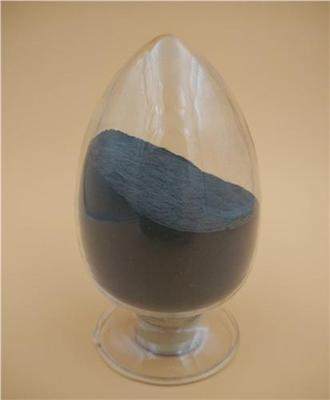1. Introduction of molybdenum disilicide ceramics
Molybdenum disilicate ceramics are gray, with metallic luster and high melting point. They are important silicide ceramics.

Molybdenum disilicide powder
2. Manufacturing process of molybdenum disilicide ceramics
(1) Preparation of molybdenum disilicide powder:
MoSi2 powder can be prepared by the following methods:
① Direct synthesis of Mo powder and Si powder
Mo 2Si2== MoSi2
It is synthesized by direct reaction of Mo powder and Si powder, the purity of Mo powder is 99.9%, the purity of Si powder is 99.0%, and the particle size of the two powders is 2~5μm. After the two powders are uniformly mixed according to the chemical formula ratio, a mixture of MoSi, Mo2Si2, and MoSi2 are synthesized by reaction. Then the reactants are crushed and purified to obtain pure MoSi2.
②Vapor deposition method
The reaction of metal halides or metals with SiCl4 and H2 are as follows:
MoCl5 2SiCl4 13/2H2==MoSi2 13HC1 or Mo 2SiCl4 4H2==MoSi2 8HCl
(2) Forming and sintering of molybdenum disilicide ceramics
Molybdenum disilicide ceramics can be made by atmospheric sintering or hot pressing sintering. If molding, can use dextrin, starch, glycerin and so on as the binder, or other binder can be formed under 80. 0MPa pressure; If it is formed by extrusion, 2%~4% dextrin can be added to MoSi2 powder as binder to form plastic and then extruded. After drying, the billet is sintered at 1500~1900℃ in non-oxidizing atmosphere such as hydrogen, nitrogen or argon.
If a small amount of SiO2 is added to the MoSi2 material, it will melt on the surface of the MoSi2 product at high temperature due to SiO2 .A layer of SiO2, which can further improve the high-temperature service performance of MoSi2, can increase the service temperature to 1710~1780 ℃.
The mechanical properties of the products made by moulding and sintering are poor, and the sintering process by hot-pressing can be made of graphite, and the hot-pressing temperature is 1550~1750℃, the pressure is 10.0~ 80.0MPa.
3. Properties and applications of molybdenum disilicide ceramics
Molybdenum disilicide ceramics have a high melting point, reaching 2030℃, and a thermal expansion coefficient of 5.1X10-6/℃ (20~1000℃). It has a high thermal conductivity, excellent oxidation resistance at high temperatures, and a suitable resistance and small temperature coefficient of specific resistance, soluble in the mixed liquid of nitric acid and hydrofluoric acid and molten alkali.
MoSi2 can be used as high temperature heating element and high temperature thermo-couple with good electrical properties and thermal shock resistance. It can be used as a melting crucible for smelting these metals and as a heat exchanger in an atomic reactor unit by virtue of its ineffectibility to molten metal sodium, lead and tin. With its excellent high temperature oxidation resistance, it can be used to manufacture some parts of ultra-high-speed aircraft, rockets and missiles.

Molybdenum disilicate electric heating element






